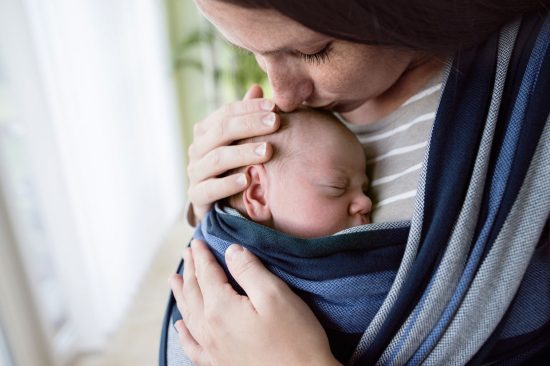Baby slings and carriers can be useful for freeing up your hands and more. Here we explain what they are, breastfeeding in them and using them safely.

A sling, wrap or carrier is what you use to carry your child on your body. It’s commonly called babywearing. It’s not a new phenomenon and has been practised for centuries in different cultures. We’ll use the terms sling, wrap and carrier interchangeably in the rest of this article.
There are lots of types of slings so it’s worth finding out about the different styles, and even trying a few before you buy one. Read our article Which baby carrier, wrap or sling is best for me? to find out more.

Unfortunately, some babies have been injured and even died in unsafe baby slings and carriers, although this is very rare.
Non-fatal injuries were mainly caused by dropping or the adult falling, while deaths were caused by positional asphyxiation. (Positional asphyxiation is where the baby’s body position blocks their breathing and they suffocate if this goes unnoticed.) These risks have led to tighter safety standards for slings and carriers to keep babies safe.
If your baby was born with a low birth weight or has a medical condition, please discuss the safe use of a carrier or sling with a health professional. Remember to be aware of your child and check them regularly, especially if your baby is under four months old.
When it comes to using slings, it’s very important to make sure you’re following a few simple guidelines. You’ll need to check the manufacturer’s instructions, following their advice for whether the size, weight and age of your baby is right for the sling.
Make sure you read and follow the UK Sling Consortium’s TICKS checklist.
Before you use the sling or carrier, check for signs of wear and tear. Don’t use it if you have any concerns. The safest type of sling or carrier keeps the baby solidly against the parent’s body in an upright position and distributes the child’s weight evenly across the wearers’ shoulders, hips and back.
When your baby is in the wrap, check them often, making sure nothing is blocking their nose and mouth. Also make sure you read and follow the UK Sling Consortium’s TICKS checklist.
A recommended position is known as the spread squat, jockey position or M-position. The spread squat is where the baby is facing their adult and has their thighs spread around the wearer’s torso. The baby also has their hips bent so their knees are slightly higher than their buttocks, or at buttock level with the thighs supported.
This practice is beneficial for at least the first 6 months for correct hip development, and also encourages social development as they are facing their caregiver. It is particularly important if a baby is being held in a sling for long periods of time. Read more about hip dysplasia (hips growing abnormally) in our article about it.
Using a sling while breastfeeding is associated with a longer duration of breastfeeding, due to convenience and the increased responsiveness that comes with keeping a baby close throughout the day. It’s important to know how to do it safely though.

Do make sure you check the manufacturer’s instructions as some suggest you don’t breastfeed in their slings. Here are our tips:
1. Most people will stop and settle so they breastfeed while stationary. However, if you are feeding on the go then keep an eye out for trip hazards.
2. Check your baby can breathe easily. A healthy baby will never compromise their own ability to breath, but a poorly one may struggle.
3. Support your baby at all times.
4. You can breastfeed vertically or in a more laidback position. While you will still have to use your hands, the sling can give you more freedom to move. It also frees up one hand to help you get your latch sorted.
5. After feeding, ensure your baby is facing up and their head is clear of the sling and your body.
Our support line offers practical and emotional support with feeding your baby and general enquiries for parents, members and volunteers: 0300 330 0700.
You might find attending one of our Early Days groups helpful as they give you the opportunity to explore different approaches to important parenting issues with a qualified group leader and other new parents in your area.
Make friends with other parents-to-be and new parents in your local area for support and friendship by seeing what NCT activities are happening nearby.
For more information on the slings available, find your nearest NCT sling library. Our sling libraries have a wide variety of slings and carriers to try and hire so you can find which one works best for you.